Original URL: https://www.theregister.com/2009/10/09/review_e_car_toyota_prius_4g/
Toyota Prius fourth-generation e-car
Still king of the hybrid hill?
Posted in Science, 9th October 2009 11:02 GMT
Review While the name Prius hasn't achieved the same degree of synonymity as Transit or Mini, it's still the one nine out of ten motorists will think of when you say the word 'hybrid'. You can thank Brad Pitt and Leonardo DiCaprio for that, and the fact that Toyota have sold 1.2 million of the things since the first one rolled off the production line back in 1997.
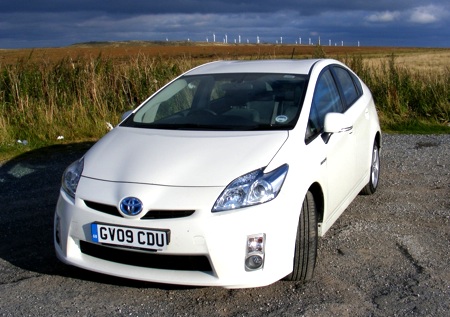
Toyota's fourth-gen Prius: greenest yet
For the Prius' fourth incarnation, Toyota has delivered a car that is entirely new. And so it needs to be because Honda is also now competing for hybrid market share with its equally clean-sheet-of-paper Insight - reviewed here.
We said all that needed saying about the physical similarities between the Insight and the Prius when we reviewed the former in August. Driving the Prius has only reinforced the similarities. A couple of casual observers even asked when we had changed the colour of our car.
Despite being marginally longer overall and in wheelbase than the Insight – 4.46/2.70m vs 4.40/2.56m – the Prius is only slightly more spacious in the rear. While boot space is also a little better, you still won't be using it to shift wardrobes about. Sit up front and there's very little in to choose between the two cars when it comes to space.
Rear visibility is another feature that is equally poor in both the Prius and the Insight, but our top of the range T-Spirit test car came with a handy combined satnav and rear-view camera which made reversing less of a gamble - as did rear headrests smaller than those found in the Insight.
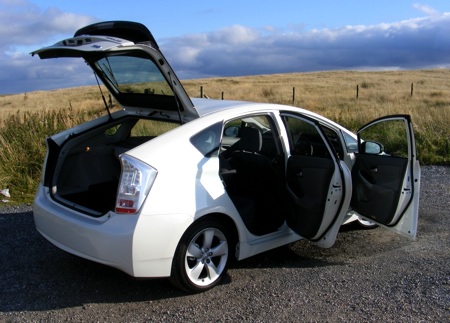
Five doors but not acres of space
Settle in behind the wheel of the Prius in the rather stiff seats and press the on/off button – nothing so arcane as a key here – and... nothing happens. Well, nothing other than the central LED dash display coming on and the word Ready appearing.
The Prius assumes that that being an environmentally caring type you will be moving away from rest slowly rather than attempting a quarter-mile drag start and so prepares to drive using battery power only. The petrol engine only fires up when you push the throttle pedal down harder to gain speed.
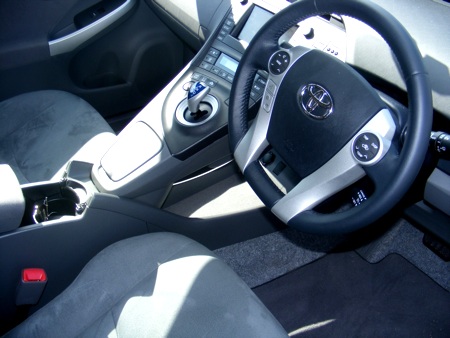
Yhe fly-by-wire joystick gear selector and key-less ignition are answers to questions no one is asking
Though basically a parallel hybrid like the Insight's Integrated Motor Assist system, Toyota's Hybrid Synergy Drive is a rather more complex bag of bolts that enables a greater degree of variation in power flow between the engine, the battery, the electric motor and the drive wheels, including a pure EV mode.
This is what really separates the Prius from the Insight: the EV button on the flying-buttress centre console. Press it and the Prius' petrol engine is taken completely out of the loop and drive comes exclusively from the 80bhp/153lb-ft (60kW/207Nm) electric motor and 13.1kWh nickel-metal hydride battery.
Assuming the battery is fully charged, the EV mode will get you about one and a quarter miles down the road at speeds of up to 32mph before the petrol engine resumes duty. 1.25 miles may not sound like much but if you're canny, you can manage to spend a fair amount of a low-speed urban commute driving in EV mode. And of course it means you can swap cars around in the drive and so forth without using a drop of petrol.
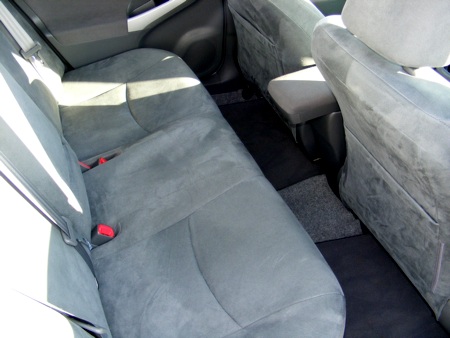
Rear legroom? Yes, it has some
When put to the test – by repeated loops of a local supermarket carpark one quiet Sunday morning, if you must know – we actually got an indicated 1.8 miles out of the battery, though admittedly this was at speeds of below 20mph. As with all battery-driven cars the faster you go, the less distance you cover.
Apart from the EV driving mode, the Prius can also be set to operate in "Eco" and "Power" modes. In the former setting, aggressive accelerator movements are moderated and the air conditioning is adjusted all in the name of improved fuel economy, while in the latter mode, given throttle inputs result in anything up to 25 per cent more wallop being unleashed.
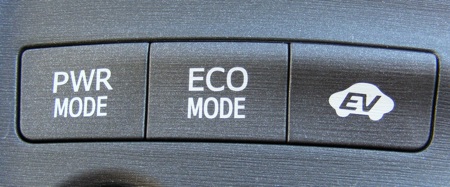
Pick your mode... but EV's probably the only one worth selecting
According to Toyota, the Prius in Power mode will cover the 30-50mph dash 1.7 seconds faster than normal, but we suspect 99 per cent of drivers will just leave the system in Auto when not cruising about in EV mode as frankly neither setting makes a massive amount of difference to economy or performance.

Leave it in Auto
Like the Insight, the Prius uses a CVT transmission which means the 1.8l VVT-i Atkinson cycle engine has to gallop up the rev range before any serious forward motion takes place. It's not the world's most refined four pot when all's said and done, and progress is not a heck of a lot faster or more enjoyable for the enthusiastic driver than in the 1.3l Insight.
This is also has a lot to do with the the fact that, as with the Honda, the Prius' petrol engine produces its maximum 98bhp (73kW) of power and 105lb-ft (142Nm) of torque rather high up the rev range, at 5200 and 4000rpm, respectively.
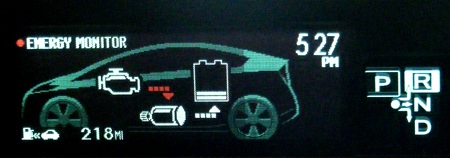
The dash thankfully avoid eco flim-flammery
On paper, with 98bhp on tap from the petrol engine and a further 80bhp available from the electric motor, we expected the Prius to show the Honda - which only has 88 and 13.8bhp, respectively - a clean pair of heels on the open road. But while the Prius does dispatch the 0-60 dash a good deal more quickly - in 10.4 seconds compared to 12.5 - when it comes to mid-range acceleration, the difference feels marginal.
Where the Prius does win out is in fuel consumption. Toyota reckons the Prius can average 72.4mpg. During our week with the car we averaged 59.2mpg. The worst we managed was 49.8 in heavy urban driving, while the best was 65.3 on a 120-mile run along the A55.
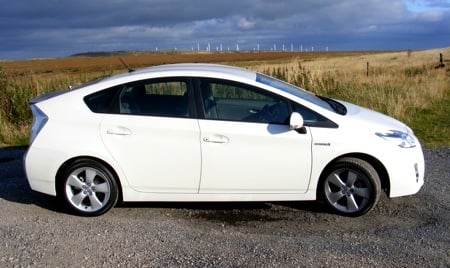
Sledgehammer seeks nut
Those numbers are significantly better than the Insight's and suggest that while the Prius doesn't deploy its extra electric motor power for the benefit of performance, it does so for the benefit of economy. At the end of the day, that's why you buy a car like the Prius.
With CO2 emissions of between 86 and 97g/km, the Prius also beats the Insight on vehicle excise duty. Coming in as it does below the CO2 VED cut-off point, the Prius won't cost you a penny in car tax.
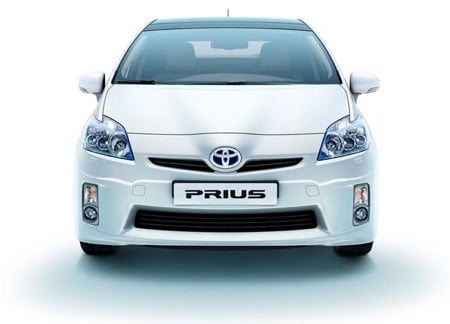
Nosing ahead of the Insight?
The flip side of that trick hybrid transmission is, of course, cost and its the reason the new Prius range starts at the best part of £2500 more than the Insight. It also consumes a fair amount or rare earth metals – apparently each Prius motor uses 1kg (2.2lb) of neodymium, which is a lot of iPod headphones in anyone's book.
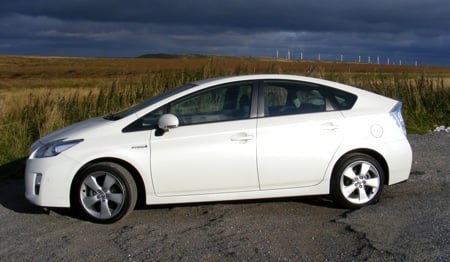
If only more power came from those windmills in the distance
All told, it's just a little hard to not come to the conclusion that the Prius is a bit of a technical sledgehammer designed to crack the nut of the Americans not liking diesels.
Out on the open road, the Prius driving experience is not far removed from that of the Insight being typical for a mid-sized front-wheel drive hatchback running on low rolling resistance tyres optimised for economy rather than grip. This is not a car you stuff into a corner in pursuit of thrills, spills and grins.
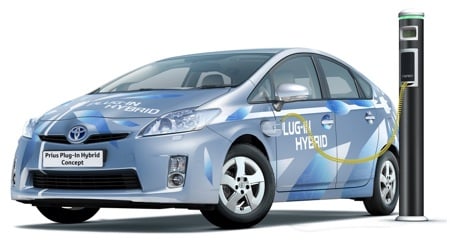
The Prius we really want to see
We found the brakes to be both fierce and rather lifeless. While driving on badly potholed roads, the Prius was less inclined to crash about than the Honda, but the cabin was prone to more rattles and squeaks. In fact, taken as a whole, the Prius' cabin felt just a little low-rent in places with much of the plastic cladding feeling cheaper and more brittle than that used by Honda.
Toyota has resisted the temptation to plaster the LED multi-function display with patronising eco flim-flammery, but we think the fly-by-wire joystick gear selector and key-less ignition are both answers to questions nobody really needed answering.
You might expect the extra money a Prius will cost you over an Insight should to bring you more in the way of toys but all you get is a head-up display that projects the speed onto the windscreen - a distracting toy best left switched off. And while you do get a 3.5mm audio connector and the option of an iPod dock you can't specify the equivalent of Honda's USB audio connector.
Verdict
The EV button makes all the difference and allows the Prius to operate as a genuine battery powered vehicle. Despite the extra on-paper power and performance, the Prius doesn't beat Honda's Insight on the road as thoroughly as we expected, while the cabin is also a rather less refined place to sit. Features like the key-less ignition and HUD speed display are gadgets for gadgets sake. It's in the economy stakes that the Prius really wins the fight and for that reason we reckon its worth the extra money over an Insight. ®
More e-Car Reviews...

Honda Insight |

Mitsubishi iMiEV |